
Captain Ralph S. Barnaby, U.S. Navy (Ret.) won the Aerobatics, Professional category at the 1967 International Paper Airplane Contest. He was persuaded to write a book, which came out in 1968, titled, “How To Make & Fly Paper Airplanes,” published by Scholastic Book Services. I used this book to learn how to make and fly the prize-winning plane, and continue to make and fly planes based on the Barnaby design. What follows is an excerpt from that book, long out of print, although it went through at least 7 editions.
The Barnaby and Other Models
I had the good fortune to grow up during the years that the Wright brothers were building and flying their aircraft. During the summer of 1908, the Wrights were making their first public flights — Wilbur in Europe and Orville in the United States. I was spending the vacation working in my father’s engineering office in New York City. I followed eagerly the reports of the Wrights’ exploits and resolved then that aviation would be my field. I started folding up and flying paper airplanes, using office stationery. That explains my preference for 8 1/2-by-11-inch bond.
The model I developed then has remained substantially unchanged over the years. It resembles more than most models I know the popular light airplanes like the Piper Cub, the Aeronca and the Cessena. Like them, the Barnaby is a versatile flier. With slight adjustments, it is capable of performing straight glides, right and left circles that return to the hand of the launcher, and perfect loops.
For a really neat job, you’ll need a pair of scissors to cut the paper to its final planform. But it is quite possible to tear the paper to shape by hand and get acceptable results. In fact, I acquired my tearing skill while making free balloon flights from Wright Field, near Dayton, in the late 1920’s. I would while away the time by tearing out, folding up and dropping paper gliders from the balloon–then watch them circle below until lost from sight.
How To Build A Barnaby Model

Here’s how to make a Barnaby model. Take a sheet of 8 1/2-by-11-inch bond paper and fold it in half widthwise. Open it and lay it crease down on a hard flat surface. This crease will be the model’s centerline.
Fold over a 1/4-inch strip along one of the 11-inch edges. Do this in one operation, using the fingers of both hands. The fold must lie flat. Continue folding until at least one-half of the sheet has been folded up. Remember, each fold must be carefully flattened in a separate operation. Otherwise, you may build a twist into the leading edge. Later, when you try to adjust the model, the wings will not align.

Now bring the two rolled-up tips together and press again along the centerline. Hold the paper in this position and carefully cut or tear along the dotted line, as indicated in the figure. Spread the model out flat and turn up a quarter inch of each wingtip to make wing fins. These fins should be parallel to the centerline and perpendicular to the wings.
Next, fold down the outer portions of the tail surfaces to make rudders, following the angle made by the dashed lines in the figure. Note that these folds are not parallel to the centerline but toe in slightly toward the nose.
With the thumb and index finger, bend up a small portion of the rolled-up leading edge at the centerline. This raised portion will act as a truss to stiffen the wings laterally and hold them at the proper angle.
Now camber the wings by scratching along their trailing edge. Hold the model by the tail, between the thumb and first two fingers with the index finger on top and check for symmetry. If necessary, add more camber to one wing or smooth one out until the two are identical.
Also check for wingtip symmetry by viewing the model from the side. If the leading edge has been folded right, the creases of the wingtip fins will appear parallel to the centerline. (i) If the leading edge has not been folded right, these fins may be twisted down (j), or one may be twisted down and the other up (k). It’s practically impossible to get rid of such a fault once it has been folded into the paper. It’s easier to start over again with a fresh sheet of paper.
Finally give the model a little up-elevator by pinching a bit of the center fold at the tail (l)
You are now ready for launch. Hold the model as shown in the figure and push it gently away from you on a slightly downward path. If you have correctly executed each step in construction, your model should glide along nicely. If not, adjustments must be made.

How to Make Adjustments
If the model dives into the ground, give it a little more up-elevator by cambering the trailing edge of the tail upward by pinching the fold in the tail a little tighter. If the model follows an undulating path, it has too much up-elevator. Try flattening down the trailing edge of the tail. If this doesn’t work, chances are your Barnaby is tail-heavy because you did not roll up enough paper in the leading edge. This can be corrected by adding a paper clip to the nose.
If the model glides all right but tends to yaw, check again for symmetry. Make sure both wings have the same amount of camber. And make sure, too, that both rudders have the same amount of tow-in. If the airplane still tends to yaw, increase the camber on the side to which it turns. Then bend the trailing edge of the rudders toward the other side. Remember to keep your corrections small.
[…] The Barnaby « Howard Fink […]
Pingback by Tapping Details to the Emotional Freedom | acneadvocate.com — July 26, 2010 @ 8:44 am
Howardfink…
[…] something about howardfink[…]…
Trackback by Howardfink — July 26, 2010 @ 8:06 pm